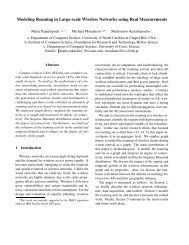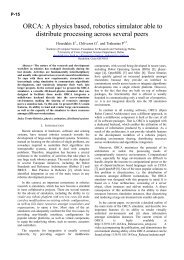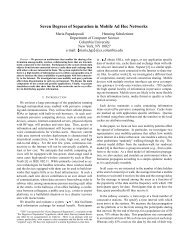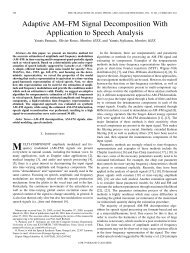Faceted Taxonomy-based Information Management - ICS
Faceted Taxonomy-based Information Management - ICS
Faceted Taxonomy-based Information Management - ICS
You also want an ePaper? Increase the reach of your titles
YUMPU automatically turns print PDFs into web optimized ePapers that Google loves.
<strong>Faceted</strong> taxonomy<br />
A B C D<br />
CTCA expression<br />
e=((A N B) ⊕ P C) N2D<br />
expression<br />
mining<br />
complete<br />
& valid<br />
navigational<br />
trees<br />
Materialized faceted taxonomy<br />
A B C D<br />
object base<br />
Materialized (non-faceted)<br />
taxonomy<br />
object base<br />
partitioning<br />
terms to facets<br />
missing<br />
terms<br />
Figure 3. Various scenarios involving CTCA<br />
longer reflect the domain knowledge originally expressed<br />
in e. In [12], we describe how we can revise a CTCA expression<br />
e after a taxonomy update, such that the new expression<br />
e ′ is well-formed and its semantics (defined valid<br />
compound terms) is as close as possible to the semantics of<br />
the original expression e before the update. Figure 4 illustrates<br />
the problem.<br />
<strong>Faceted</strong> taxonomy<br />
F<br />
Update<br />
of F by<br />
designer<br />
?<br />
CTCA expression<br />
e<br />
Automatic<br />
revision of e<br />
Compound terminology<br />
defined by e<br />
S F e<br />
F’ e’ S F’ e’<br />
Min distance<br />
Figure 4. Revising CTCA expressions after<br />
taxonomy updates<br />
The deletion/addition of terms or subsumption relationships<br />
in a faceted taxonomy can be handled by extending<br />
the P/N parameters of the CTCA expression e, such that<br />
missing compound terms are recovered and extra ones are<br />
removed. However, the addition of a subsumption relationship<br />
in a faceted taxonomy cannot be handled, so straightforwardly.<br />
The reason is that, since the semantics of the operations<br />
⊕ P /⊖ N are defined on the basis of the transitive<br />
relation ≼, after the addition of a subsumption relationship<br />
we may no longer be able to separate (from the semantics)<br />
compound terms that were previously separable (i.e., compound<br />
terms which were not ≼-related before the addition<br />
of the subsumption link). In such cases, the resulting compound<br />
terminology of any revised expression may neither<br />
be subset nor superset of the original compound terminology.<br />
The treatment of such cases is described in detail in<br />
[12].<br />
5 Integration and Personalization of<br />
<strong>Taxonomy</strong>-<strong>based</strong> Sources<br />
Assume that we have two taxonomy-<strong>based</strong> sources and<br />
that we want to establish mappings between their taxonomies.<br />
If they share instances then the ostensive method<br />
described in [16] can be used. Cornerstone of this method is<br />
what is called naming function (also analyzed in [17]). Let<br />
S be the extension of Ī (for the definition of Ī, see Table 1)<br />
over the set of positive queries Q + (i.e., the set of boolean<br />
expressions of terms with no negation). As S is not always<br />
an onto function (if we consider it as a function from Q + to<br />
the powerset of Obj), “approximate” naming functions to a<br />
set of objects A are introduced, specifically a lower naming<br />
function n − and an upper naming function n + , defined as<br />
follows:<br />
n − (A) = lub{ q ∈ Q + | S(q) ⊆ A}<br />
n + (A) = glb{ q ∈ Q + | S(q) ⊇ A},<br />
where A ⊆ Obj, lub stands for least upper bound, and glb<br />
stands for greatest lower bound with respect to the query<br />
containment ordering. It is proved that:<br />
n + (A) ∼{D I (o) | o ∈ A}<br />
n − (A) ∼{D I (o) | o ∈ A, S(D I (o)) ⊆ A},<br />
where D I (o) = ∧ {t ∈ T | o ∈ I(t)}. The time complexity<br />
for computing these names is polynomial. The ostensive<br />
method can also be used as a protocol for establishing mappings<br />
between sources that are stored distributed. In brief,<br />
in order to map a term or query q of a source S 1 to a term<br />
or query of a source S 2 , S 1 sends its answer O 1 = S(q) to<br />
source S 2 , S 2 then computes the upper and lower name of<br />
the objects received (i.e., n − (O 1 ) and n + (O 1 )) and sends<br />
these names (accompanied by their answers) to S 1 . The<br />
latter, by comparing the object set sent with the answers received,<br />
establishes relationships between q and the received<br />
names.<br />
S1<br />
Thessaloniki<br />
Pilio<br />
Iraklio<br />
Mainland<br />
Greece<br />
Islands<br />
Macedonia<br />
Ipiros Eptanisa Crete<br />
Ipiros<br />
S2<br />
Kefalonia<br />
Eptanisa<br />
Kerkira<br />
Mediator<br />
Ionian<br />
Kefalonia<br />
S3<br />
Islands<br />
Rethymno<br />
Aegean<br />
Crete<br />
Iraklio<br />
Figure 5. <strong>Taxonomy</strong>-<strong>based</strong> mediators<br />
Suppose that we have different taxonomy-<strong>based</strong> sources<br />
and that we wish to provide a unified browsing or query interface<br />
to their indexed objects, either through one of the<br />
existing taxonomies or a new one. Then, <strong>based</strong> on intertaxonomy<br />
mappings (defined either manually or using the<br />
ostensive method described previously), we can build a mediator<br />
system as illustrated in Figure 5. In [18], we describe
















